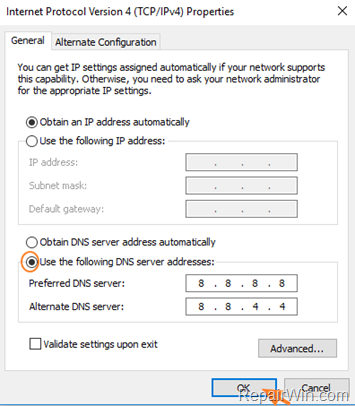This tutorial contains instructions to fix the Chrome error: “ERR_CERT_AUTHORITY_INVALID”. The “Your connection is not private: NET::ERR_CERT_AUTHORITY_INVALID” error in Chrome, appears when you visit HTTPS sites and the web browser can not verify the site’s SSL certificate, either because the certificate is not come from a trusted publisher or because the connection between the client and the server can not be established or is not secure.

The primary goal of SSL technology, is to provide a private and secure connection between the client machine (e.g. between your web browser and the website you try to visit). To accomplish this task, an SSL certificate (also know as “digital certificate”) is installed on a web server in order to authenticate the identity of the website and to encrypt the data that transmitted on it. In fact, SSL technology is a cryptographic mechanism that provides security protection to the sensitive data you enter (e.g. username or password) on websites that require or collect sensitive information (e.g. Banks, Medical or Financial sites, etc.). The websites that uses the SSL protocol, can be easily recognized, because they use the HTTPS URL prefix instead of HTTP.
How to FIX: Connection is not private – NET::ERR_CERT_AUTHORITY_INVALID error in Chrome.
Nội dung
Advice: Before proceeding to apply the methods below, to resolve the Google Chrome error: “NET::ERR_CERT_AUTHORITY_INVALID”, try the following:
1. Ensure that your system has the correct Date & Time.
2. If you own another computer/device in your place, then try to visit the website where your receive the “NET::ERR_CERT_AUTHORITY_INVALID ” error, in order to make sure that the site you ‘re trying to visit is not blocked from your ISP.
3. If you have setup a VPN connection, then disconnect from it.
4. Temporarily disable the Firewall application (if you have one).
5. Some users, have reported that the “NET::ERR_CERT_AUTHORITY_INVALID” error in Chrome, is caused if the AVAST or the BitDefender antivirus is installed on the system. Therefore, if you ‘re using Avast or BitDefender, follow the instructions at method-3 below to disable the web protection, or uninstall the antivirus software and see if the problem persists.
Method 1. Scan your computer for Malware & Viruses.
The first step before troubleshooting the error ERR_CONNECTION_RESET in Chrome, is to ensure that your system is virus/malware free. For that task follow the instructions in this guide: How To Scan Your Computer for Viruses and other Malicious Programs.
Method 2. Change DNS settings.
– Use Google’s Public DNS Servers to resolve the “ERR_CERT_AUTHORITY_INVALID” error in Chrome.
To Change the DNS Settings:
1. Right click on the active Network icon in Taskbar (or go to to Windows Control Panel) and click Network and Sharing Center
![image_thumb[14] image_thumb[14]](https://qnet88.com/wp-content/uploads/2021/12/image_thumb14_thumb-2.png)
2. Select the Active Network Card and then click Change adapter options.
![image_thumb[17] image_thumb[17]](https://qnet88.com/wp-content/uploads/2021/12/image_thumb17_thumb-2.png)
3. Right click on your active Network Adapter and select Properties.
4. Select the ‘Internet Protocol Version 4 (TCP/IPv4)’ and click Properties
![image_thumb[18] image_thumb[18]](https://qnet88.com/wp-content/uploads/2021/12/image_thumb18_thumb.png)
5a. Check the “Use the following DNS server addresses:” radio button.
5b. Type the following DNS server addresses (Google’s public DNS Servers) and click OK.
- 8.8.8.8
- 8.8.4.4

6. Restart your computer.
Method 3. Check your Firewall Settings.
If you use a third party firewall or antivirus program to filter the Internet traffic, try to temporarily disable the Web (Internet) protection or disable the “HTTPS Scanning” or the “HTTPS protection” feature.
- If you ‘re using AVAST antivirus then disable the HTTPS Scanning. To do that:
- Open Settings -> Active Protection -> Web Shield –> Customize -> uncheck the Enable HTTPS scanning box.
- If you using BitDefender antivirus, then disable the Scan SSL feature. To do that:
- Open Settings –> Privacy Control, select the Antiphishing tab and set the Scan SSL to OFF. (In Bitdefender Total Security 2015 go to: Protection –> Web Protection –> Disable Scan SSL)
Method 4. Completely uninstall and re-install Chrome.
Completely remove and re-install Chrome from your PC, by using the instructions on this tutorial: How to Uninstall Google Chrome completely from your computer.
That’s all folks! Did it work for you?
Please leave a comment in the comment section below or even better: like and share this blog post in the social networks to help spread the word about this solution.
Bài liên quan
- FIX: Error 0x81000203 in System Restore. (Solved)
- Cannot Access Shared folder. User has not been granted the requested logon type at this computer. (Solved)
- FIX: Cannot clear TPM – 0x80284001, 0x80290300 or 0x80290304.
- Unable to Schedule Teams Meeting in 15 or 10 minutes slots (Solved)
- How to Share Folder without Username/Password on Windows 10/11.
- FIX: Thunderbird High CPU or Memory Usage issues.